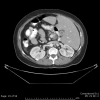Pancreatic adenocarcinoma in a patient with situs inversus: a case report of this rare coincidence
- PMID: 20021643
- PMCID: PMC2803176
- DOI: 10.1186/1477-7819-7-98
Pancreatic adenocarcinoma in a patient with situs inversus: a case report of this rare coincidence
Abstract
Background: Situs inversus (SI) is a relatively rare occurrence in patients with pancreatic adenocarcinoma. Pancreatic resection in these patients has rarely been described. CT scan imaging is a principle modality for detecting pancreatic cancer and its use in SI patients is seldom reported.
Case presentation: We report a 48 year old woman with SI who, despite normal CT scan 8 months earlier, presented with obstructive jaundice and a pancreatic head mass requiring a pancreaticoduodenectomy. The surgical pathology report demonstrated pancreatic adenocarcinoma.
Conclusion: SI is a rare condition with concurrent pancreatic cancer being even rarer. Despite the rarity, pancreaticoduodenectomy in these patients for resectable lesions is safe as long as special consideration to the anatomy is taken. Additionally, radiographic imaging has significantly improved detection of early pancreatic cancer; however, there continues to be a need for improved detection of small neoplasms.
Figures



Similar articles
-
Perioperative challenges associated with a pancreaticoduodenectomy and distal pancreatectomy for pancreatic cancer in patients with situs inversus totalis: report of two cases.Surg Today. 2010;40(1):79-82. doi: 10.1007/s00595-009-4064-z. Epub 2009 Dec 29. Surg Today. 2010. PMID: 20037847
-
The First Report of Laparoscopic Pancreaticoduodenectomy for Primary Duodenal Carcinoma in a Patient With Situs Inversus Totalis: Report of a Rare Case.Surg Laparosc Endosc Percutan Tech. 2019 Jun;29(3):e29-e33. doi: 10.1097/SLE.0000000000000659. Surg Laparosc Endosc Percutan Tech. 2019. PMID: 30889057
-
Common bile duct adenocarcinoma in a patient with situs inversus totalis: report of a rare case.BMC Res Notes. 2012 Dec 12;5:681. doi: 10.1186/1756-0500-5-681. BMC Res Notes. 2012. PMID: 23234596 Free PMC article.
-
[Adenocarcinoma of pancreas with situs viscerum inversus totalis].Minerva Chir. 2003 Apr;58(2):243-6. Minerva Chir. 2003. PMID: 12738934 Review. Italian.
-
Transverse colon cancer with obstruction in a patient with situs inversus totalis: A case report and review of literature.Asian J Surg. 2020 Dec;43(12):1186-1188. doi: 10.1016/j.asjsur.2020.09.003. Epub 2020 Sep 28. Asian J Surg. 2020. PMID: 32994114 Review. No abstract available.
Cited by
-
Pancreaticoduodenectomy for biliary tract carcinoma with situs inversus totalis: difficulties and technical notes based on two cases.World J Surg Oncol. 2013 Dec 17;11:312. doi: 10.1186/1477-7819-11-312. World J Surg Oncol. 2013. PMID: 24341840 Free PMC article.
-
Heterotaxy polysplenia syndrome with cholangiopancreatic cancer: a case report and literature review.Front Med (Lausanne). 2025 Jun 9;12:1537227. doi: 10.3389/fmed.2025.1537227. eCollection 2025. Front Med (Lausanne). 2025. PMID: 40552176 Free PMC article.
-
Solid pseudopapillary neoplasm of pancreas in a patient of situs inversus totalis.BMJ Case Rep. 2019 Aug 28;12(8):e231644. doi: 10.1136/bcr-2019-231644. BMJ Case Rep. 2019. PMID: 31466964 Free PMC article.
-
Modified palliative biliary stenting in situs inversus totalis patient with carcinoma gallbladder: feasibility and technical details.Transl Gastroenterol Hepatol. 2017 Mar 30;2:27. doi: 10.21037/tgh.2017.03.01. eCollection 2017. Transl Gastroenterol Hepatol. 2017. PMID: 28447062 Free PMC article.
-
Solitary adrenal metastasis from advanced gastric cancer invading duodenal bulb with situs inversus totalis: A case report.Medicine (Baltimore). 2019 Apr;98(15):e15244. doi: 10.1097/MD.0000000000015244. Medicine (Baltimore). 2019. PMID: 30985730 Free PMC article.
References
-
- Legmann P, Vignaux O, Dousset B, Baraza AJ, Palazzo L, Dumontier I, Coste J, Louvel A, Roseau G, Couturier D, Bonnin A. Pancreatic tumors: comparison of dual-phase helical CT and endoscopic sonography. AJR Am J Roentgenol. 1998;170:1315–1322. - PubMed
-
- Kosaki K, Casey B. Genetics of human left-right axis malformations. Cell & Developmental Biology. 1998;9:89–99. - PubMed
Publication types
MeSH terms
LinkOut - more resources
Full Text Sources
Medical

